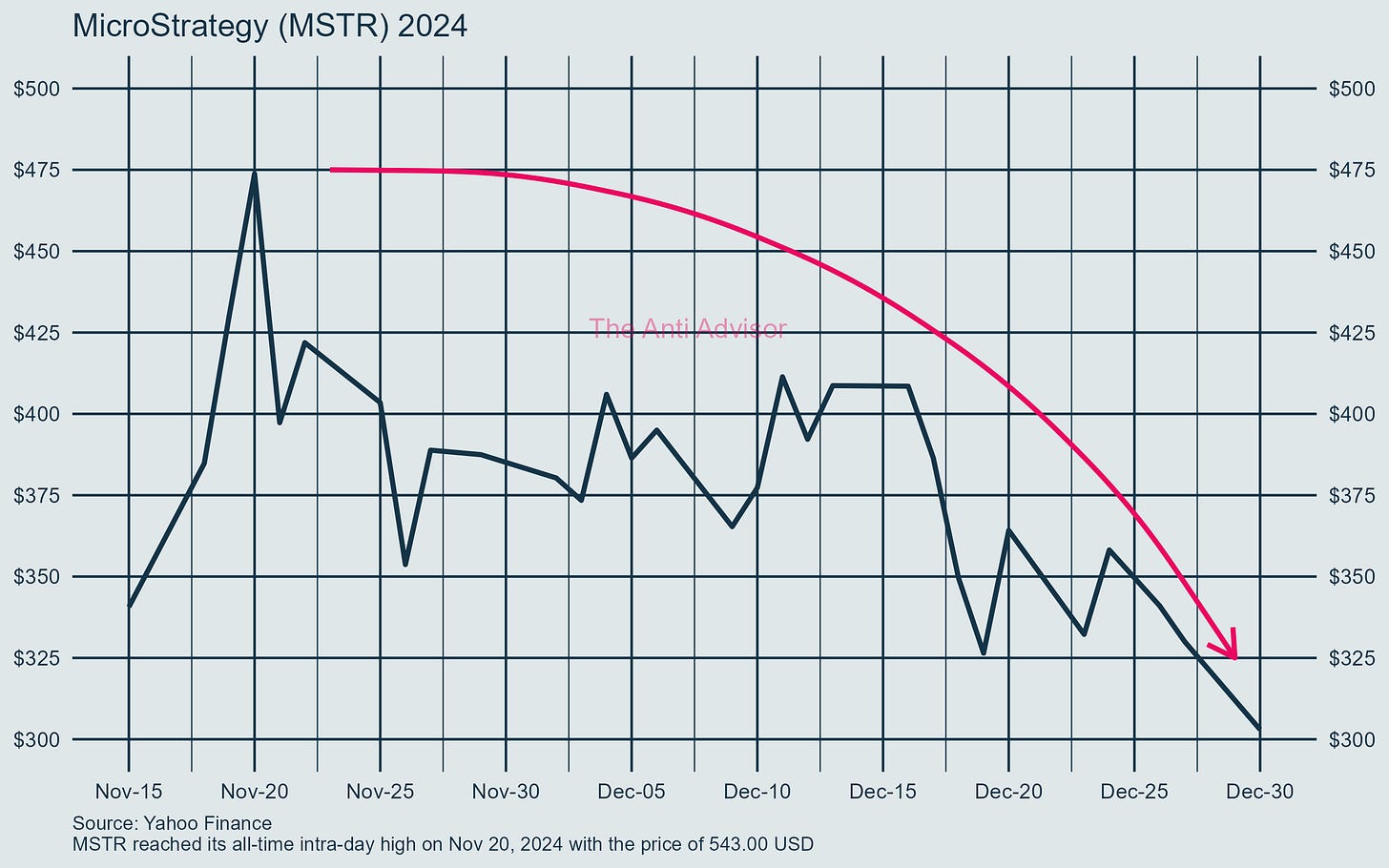Imagine this scenario:
An investor watches their 185 shares of MicroStrategy (MSTR) fall from $550 to $500. Convinced it's just a temporary dip and wanting to lower their average cost, they double their position. When it falls to $400, they double down again, this time using margin. By the time MSTR hits $300, they've transformed what was initially a $9,250 loss into a $120,000 catastrophe.
Summary (with 15% Margin Interest):
Initial investment: $101,750 (185 shares at $550).
After doubling at $500: 370 shares, total cost $194,250, loss $9,250.
After doubling at $400 (using margin):
740 shares, total cost: $342,250
Margin interest for 1 month: $1,850.
Adjusted cost basis: $344,100
Average cost per share: ≈$465
At $300:
Final value: 740 × $300 = $222,000
Total loss (including margin interest): $122,100
The real damage? It's not just financial – it's the emotional scars that change how they approach investing forever.
This pattern repeats itself across markets, regardless of experience level. Psychology is almost mathematical in its consistency:
A significant loss hits
Emotions take the wheel
They drive us to try to "fix" the situation by throwing good money after bad
Revenge trading is like trying to catch a falling knife while wearing a blindfold. Your emotions tell you that you can time the catch perfectly, but you're much more likely to get hurt. The irony? The harder you try to make back your losses quickly, the more likely you are to compound them.
The Cold, Hard Math
This is where things get sobering. A 20% loss requires a 25% gain to break even. A 50% loss requires a 100% gain. When you start using margin to revenge trade, these numbers become even more daunting. A leveraged position that drops 50% might require a 200% gain just to get back to square one.
A Prevention Toolkit:
The "24-Hour Cooling Off" Rule
The most important rule in an arsenal: Never add to a losing position on the same day of a significant drop. The brain is in a fight-or-flight mode, making it physiologically impossible to make rational decisions. Give it at least one full trading day before even considering any new positions.
The "Position Size Circuit Breaker" rule
Before entering any trade, write down your maximum position size as a percentage of your portfolio. Make this number small enough that a complete loss wouldn't devastate you. When emotions are running high, this pre-set limit becomes your lifeline to rationality.
The "Three Strikes" Rule
If you've added to a losing position twice and it's still going against you, you're done. No more additions, period. This rule prevents the dangerous spiral of constantly averaging down into a falling asset.
The "Emotional Temperature"
Check Before making any trading decision, rate your emotional state from 1-10. If you're above a 7 (either excitement or fear), step away. High emotional states are nature's way of warning you that you're not thinking clearly.
The Trading Journal Revolution
Keep a detailed log of not just your trades, but your emotional state during each one. Include screenshots of charts, your reasoning for the trade, and how you felt. Review this journal monthly. You'll start to see patterns emerge – patterns that can save you from repeating expensive emotional mistakes.
Prevention in Practice
Consider the cryptocurrency crash of 2022. Investors who followed strict position sizing rules survived to invest another day. Those who kept doubling down, convinced they could "catch the bottom," often lost everything. The difference wasn't intelligence or market knowledge – it was emotional discipline and pre-set rules.
The Market's Truth
Here's the reality every investor must accept. The market is completely indifferent to your losses. It doesn't owe you a recovery. Each new investment decision should stand on its own merits, completely separate from your emotional need to "get back to even."
The best investors aren't the ones who never lose – they're the ones who lose small and maintain their emotional equilibrium. Your goal isn't to avoid losses entirely; it's to prevent emotions from turning manageable losses into account-destroying disasters.





